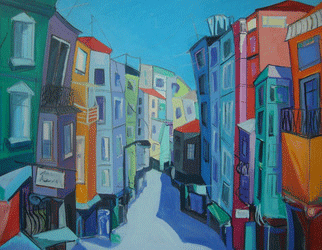
Tarlabasi, 2004, by Gamze Olgun, Oil Painting.
by Jenny White
Kamil Pasha Blog
Posted on January 24th, 2008
Tarlabasi is a district on the backside of the Beyoglu hill falling from the crest at Pera – where all the foreign embassies were in Ottoman times, now demoted to consulates – down in the direction of the Golden Horn. In The Abyssinian Proof, Kamil chases a wily criminal to his lair in Tarlabasi. The district is picturesque in the way of crumbling majesty on its last legs (a large part of Tarlabasi will be razed in 6 months, probably replaced by hotels). The steep, narrow lanes are strung with laundry, bustling with locals shopping at an outdoor market crammed into one of the lower streets. At the top of the hill near Istiklal Bouelvard are some lovely stone houses, now ruined or so shabby as to be nearly uninhabitable. A large stone house cracked down the side like an egg is posted for sale. As you walk down the hill, the houses become smaller, shabbier, sometimes outright ruins, less stone and more wood. In Ottoman times, Catholics and Greek Christians (Rum) lived near the top — shop owners, employees of the embassies — and poorer families near the bottom. Taylor Pepo’s apprentice lived in Tarlabasi with his family (The Abyssinian Proof). Today Tarlabasi is inhabited by Roma (gypsy), Kurds, the very poor, and social outcasts of various kinds.
These days Tarlabasi also has the reputation of being a den of thieves, the sort of place even the police go into only with backup. Not the sort of place I’d be wandering around by myself but I wanted to see it before it was torn down, so I went with a group of academic colleagues, two of whom actually live in Tarlabasi, close to the top of the hill and fashionable Istiklal Boulevard (formerly the Grande Rue de Pera). Sure enough, on what is called by the locals “the hill of thieves†(just a couple of blocks downhill from Istiklal) we were accosted by a boy who tried to pick our pockets. He was about 9, with an abnormally bloodless face and puffed eyes, white around the lids, probably on drugs (glue sniffing?). His fellows hung around the edges, waiting to act. A local woman told him to get away from us but he didn’t listen. No one else intervened. He kept pushing a package of tissues at us (about 20 small packets in one big package), walking in front and beside each of us, pressing the package against each of us in turn like an automaton. Under the package his hands were busy; he tried to pry my purse open but didn’t manage it. He did open the zipper of a colleague’s jacket pocket at which point he stopped and lectured the boy. We didn’t dare push him away for fear of provoking his fellows to act. Coming out onto the street below, we entered Dolapdere and Kurtulus, also poor but thriving communities. We were drawn by an idyllic coffeehouse in an alley beside a magnificent Ottoman mosque where old men in knit caps sat outside in the brisk sunshine and sipped tea. Cats lounged against the wall where two women sat on a sunny bench playing with a boy in a red windbreaker.